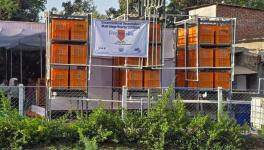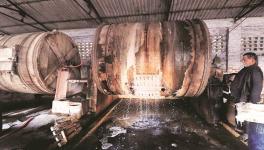Audit Report Nails Gujarat Govt for Laxity in Controlling Environmental Pollution
Representational use only.Image Courtesy: maxpixel
New Delhi: Ahead of the Gujarat Assembly polls later this year, a government audit report has found that the Bharatiya Janata Party-led state government ignored the role of privately-owned industries in contributing to environmental pollution over the past few years.
As per the report tabled in the Gujarat Assembly on September 22 by the Comptroller & Auditor General (CAG) of India, the state government had ignored the role of thermal power plants while preparing pollution mitigation plans for Ahmedabad and Surat.
The report – Performance Audit of Air Pollution Control by Government of Gujarat – has also pointed out numerous instances where the BJP-led government reneged on its responsibility to regulate, monitor and penalise industries other than thermal plants for violating environmental norms.
In February 2019, the Gujarat Pollution Control Board (GPCB) had prepared Air Action Plans for the two cities under the directions of the National Green Tribunal. However, the GPCB had bypassed Torrent Group’s 362 Mega Watt (MW) thermal power plant in Ahmedabad, which contributed as much as “66 per cent” to the total air pollution of the city. The role of thermal power plants operating around Surat was also ignored in its action plan for the city.
“In Ahmedabad city, Torrent Power Limited (TPL) operates a coal-based thermal power plant of 362 MW. However, while preparing the Air Action Plan for Ahmedabad city, emissions due to TPL which contributes significantly (66 per cent) to the total ambient air pollution was not considered by the GPCB. Similarly, fossil fuel based TPPs [thermal power plants] of a total 500 MW capacity were also operating in and around Surat but emission load due to these TPPs was not considered in the Air Action Plan of Surat,” the CAG has stated in its report.
The Central Pollution Control Board (CPCB) approved the aforementioned reports in April 2019. However, the CAG was not convinced by the Gujarat government's justification for leaving out thermal power plants from the air action plans of the two cities.
The CAG was told, upon enquiry, in June 2021, the action plan for Ahmedabad was prepared only based on a Source Apportionment Study – a study that tracks down sources of environmental pollution – conducted by the Gujarat Energy Management Institute, a state government undertaking.
“Based on the outcome of the study [Source Apportionment Study], if required, emissions caused due to TPL will be included in the Plan,” stated the audit report.
The Gujarat government also told the CAG in January 2022 that “TPPs are part of an action plan of the Ahmedabad and Surat cities as the industrial source and the format provided by CPCB for the preparation of the Air Action Plan of the city had not envisaged separate inclusion of TPPs as an individual entity.”
But the CAG’s perusal of the Source Apportionment Study revealed that the total emission load (including particulate matter and toxic oxides of Nitrogen and Sulphur) during the study period in 2018-19 was 69,123.17 kg per day; thermal power plants alone accounted for 45,794.66 kg emission per day. This amounted to 66% of the total emission load per day for Ahmedabad in 2018-19!
“No justification for non-inclusion of emission due to TPPs in the Air Action Plan of Ahmedabad was found on record. The non-inclusion of a major source of air pollution in the Air Action Plan may have an impact on designing mitigation measures,” the CAG has concluded in its report.
Gujarat has 47 units of fossil-fuel-based power plants across the state, contributing more than 10% to the country’s thermal power generation. The state government has been criticised for its handling of thermal power plants in areas other than Ahmedabad and Surat as well.
On the basis of satellite imageries captured by the US space research agency NASA and European Union’s Tropospheric Monitoring Instrument (TROPOMI), the CAG has arrived at the conclusion that the Mundra region of Gujarat is one of the worst hotspots of the country in terms of emissions of the toxic oxides of nitrogen and sulphur.
As many as 14 units of coal-based power plants with a total installed capacity of 8,620 MW were commissioned in the Mundra area between August 2009 and March 2013, which roughly corresponds to Modi’s third and fourth terms in power as Gujarat chief minister.
However, as per the CAG audit, the Gujarat government had no data or information regarding the compliance of these power plants with norms set by the CPCB to regulate emissions of toxic oxides of Sulphur and Nitrogen. Further, the audit also revealed that most of these plants had failed to adhere to norms set by the central government for the disposal and utilisation of fly ash, a toxic byproduct of coal combustion.
“Non-disposal of legacy stock of fly ash and non-compliance with norms on the utilisation of fly ash caused fugitive emission. There is a lack of emphasis by the various line departments on use of fly ash,” the audit report states.
Non-compliance with environmental norms in Gujarat is not limited to thermal power plants alone. As many as 67 of the 122 highly-polluting industries have failed to abide by the central government guidelines to install systems enabling real-time online monitoring of emissions.
Directions had been issued by the CPCB in February 2014 upon 17 categories of highly polluting industries to install these systems, which are known in technical parlance as online continuous emission monitoring system (OCEMS). Further, the CPCB had also directed the Gujarat government in March 2015 to obtain bank guarantees equivalent to 100 per cent of the cost of these systems from targeted units in order to complete installation and ensure timely compliance. The targeted date for installing these systems was June 20, 2015. However, CAG’s audit revealed that neither had the Gujarat government obtained bank guarantee in place of cost of the monitoring systems nor initiated any action against non-complying units even after six years of the order. There is no monitoring mechanism in Gujarat either to examine the efficacy of the monitoring systems that have been installed so far.
“GPCB conducts events such as rallies, exhibition, padyatras, essay competitions, paintings and drawing contests, seminars, workshops, etc., on Earth Day, World Environment Day, etc., to educate and raise awareness among stakeholders about the various requirements for environment protection and pollution control. However, GPCB has not been able to reach individual industrial units due to limited workforce,” the CAG has noted.
The use of pet coke, a combustible by-product of the oil refining process with high calorific value, is not being monitored in Gujarat despite the restrictions put upon it for its high polluting potential. Pet coke importers into Gujarat did not furnish quarterly reports to the state government about its use.
However, as per data from the Gujarat Maritime Board, more than 72 lakh tonnes of polluting fuel were imported into the state between 2017 and 2021. The government was also lax in regulating pollution caused by smaller industrial units like hot mix plants, bricks kilns, stone crushers, sawmills and icemaking plants.
In a very startling revelation, the CAG has stated that the Gujarat government has not prepared any vision document, long-term plan, policy or time-bound measures for the regulation and control of air pollution in the state. They only have the Air Action Plans for Ahmedabad and Surat despite the presence of a large number of industries in other districts too.
A set of queries were emailed to senior officials of Gujarat State Pollution Control Board, as well as to the ministers in charge of forest and environment in the state, asking why no long-term policy measure to tackle air pollution has been formulated. Queries were also made as to why the pollution caused by thermal power plants was not taken into account in the formulation of air action plans for Ahmedabad and Surat. No responses had been received at the time of publishing this news article.
The CAG report was tabled in the Gujarat Assembly five days after Prime Minister Narendra Modi’s highly-publicised 72nd birthday, on the occasion of which he had released eight Cheetahs – considered extinct in India for the past seven decades – into the Kuno National Park of Madhya Pradesh.
Notwithstanding Modi’s display of his newfound commitment toward wildlife, the audit report has pulled up the Gujarat government for failing to keep a tab on air pollution caused by industries operating within the eco-sensitive zone of Thol Wildlife Sanctuary in Mehsana district.
Air quality in the eco-sensitive zone of the Thol Wildlife Sanctuary was not being monitored despite the presence of seven polluting industries in the region. From whatever data the CAG could lay its hands upon, it was found that compliance with norms about particulate matter and oxides of nitrogen and sulphur were much beyond permissible limits.
But, is the Gujarat government concerned about the health impacts of environmental pollution upon common people irrespective of the laxity it has displayed towards industries?
As per the audit report, Gandhinagar Municipal Corporation dumps municipal solid waste near the bank of river Sabarmati. The state pollution control board had observed the “pungent smell, burning of waste causing smoke, presence of stray animals, non-segregation of plastic waste, etc. at the dumping site.” Similarly, the CAG has found that unsegregated municipal solid waste occupies “84 acres of land in the form of three 75-feet high mounds” aggregating 95 lakh tonnes at Pirana in Ahmedabad, which the municipal body of the city has been using as a dumping ground for the past 40 years.
The CAG has further found that the Gujarat government does not conduct assessments of the impact of air pollution on the health of the general population in areas across the country identified as “critically polluted” by the CPCB on account of scoring low on a range of environmental parameters. In March 2011, the CPCB had issued instructions upon all states to conduct periodic health impact assessments in areas surrounding critically polluted industrial clusters through government-registered health institutions.
As per the CAG audit, a total number of 15 hospitals located in industrial areas of Ahmedabad, Vapi-Valsad and Ankleshwar reported 80,443 patients with asthma, bronchitis and acute respiratory infections in the period 2012-13 to 2016-17. “An increasing number of patients depicts the severity of the impact of air pollution on health … Industries Association carried out health impact assessments in CPA [Critically Polluted Areas] with experts. However, GPCB has not undertaken any such assessment,” stated the report.
The Gujarat government also did not heed the directions issued by the CPCB in April 2016 for the installation of Continuous Ambient Air Quality Monitoring Stations (CAAQMS) in critically polluted areas. Till March 2021, only six systems were installed in Gujarat. These systems were not funded by the industries but were being operated by the Gujarat government through the state pollution control board.
The writer is an independent journalist.
Get the latest reports & analysis with people's perspective on Protests, movements & deep analytical videos, discussions of the current affairs in your Telegram app. Subscribe to NewsClick's Telegram channel & get Real-Time updates on stories, as they get published on our website.
























